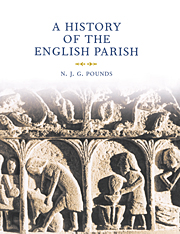Book contents
- Frontmatter
- Contents
- List of illustrations
- Preface
- List of abbreviations
- PART I THE ORIGINS OF THE PAROCHIAL SYSTEM
- PART II THE FUNCTIONS OF THE PARISH
- PART III THE PARISH AND ITS CHURCH
- 10 The parish: its church and churchyard
- 11 The fabric of the church: the priest's church
- 12 The peoples's church: the nave and the laity
- Notes
- Index
11 - The fabric of the church: the priest's church
Published online by Cambridge University Press: 29 July 2009
- Frontmatter
- Contents
- List of illustrations
- Preface
- List of abbreviations
- PART I THE ORIGINS OF THE PAROCHIAL SYSTEM
- PART II THE FUNCTIONS OF THE PARISH
- PART III THE PARISH AND ITS CHURCH
- 10 The parish: its church and churchyard
- 11 The fabric of the church: the priest's church
- 12 The peoples's church: the nave and the laity
- Notes
- Index
Summary
God is in non lond so wel seruyd in holy chyrche ne so
mychil worchepyd in holy chyrche as he is in Þis lond, for
so many fayre chirchys ne so good aray in chyrchis ne so
fayr seruyce, as men seyn, is in non oÞ thir lond as in Þis
lond.
Dives and PauperThe medieval parish church was a colourful place. Its walls were painted with moralities and biblical scenes; its windows were glazed with stained and painted glass. Figures of saints and evangelists filled the panels of its rood-screen. Even the sculptured font was picked out in colour. Little light may have penetrated the small windows of the older churches, but their interiors were illuminated by lanterns and candles. There were candles for all occasions. They stood before the rood; they illuminated the carved and painted images of saints; they were carried in procession, and, in their silver candlesticks, they stood upon the altar. Mass might not be celebrated without two lighted candles upon the altar, or, as a concession to the poorest churches, ‘at least one’. Money was bequeathed to maintain lights before images, and there were even gilds whose ostensible purpose it was to burn lights at certain times of the day, week or year. There were giant paschal candles for Easter, carefully fabricated at some considerable expense, and smaller font candles, lighted at times of baptism.
- Type
- Chapter
- Information
- A History of the English ParishThe Culture of Religion from Augustine to Victoria, pp. 430 - 463Publisher: Cambridge University PressPrint publication year: 2000



